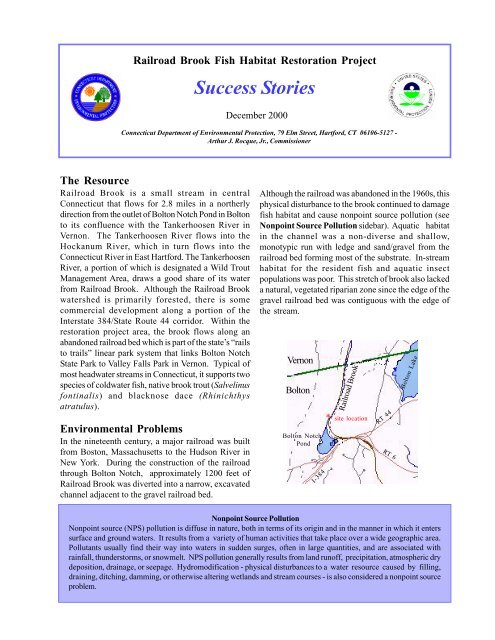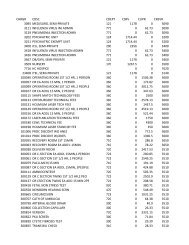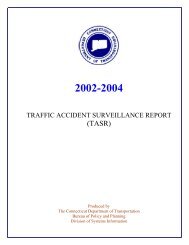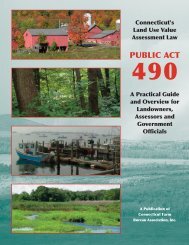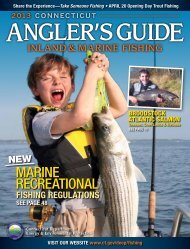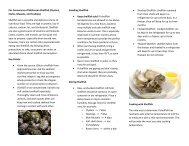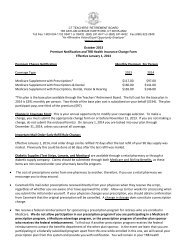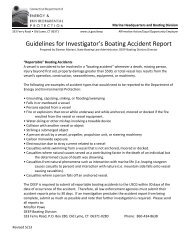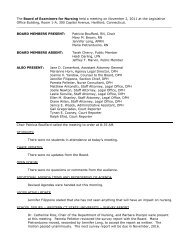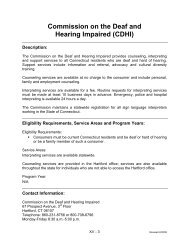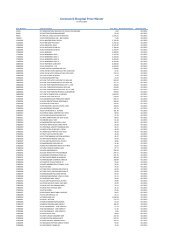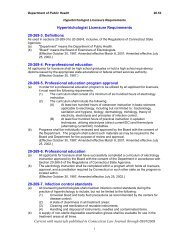Railroad Brook Fish Habitat Restoration Project - CT.gov
Railroad Brook Fish Habitat Restoration Project - CT.gov
Railroad Brook Fish Habitat Restoration Project - CT.gov
You also want an ePaper? Increase the reach of your titles
YUMPU automatically turns print PDFs into web optimized ePapers that Google loves.
<strong>Railroad</strong> <strong>Brook</strong> <strong>Fish</strong> <strong>Habitat</strong> <strong>Restoration</strong> <strong>Project</strong><br />
Success Stories<br />
December 2000<br />
Connecticut Department of Environmental Protection, 79 Elm Street, Hartford, <strong>CT</strong> 06106-5127 -<br />
Arthur J. Rocque, Jr., Commissioner<br />
The Resource<br />
<strong>Railroad</strong> <strong>Brook</strong> is a small stream in central<br />
Connecticut that flows for 2.8 miles in a northerly<br />
direction from the outlet of Bolton Notch Pond in Bolton<br />
to its confluence with the Tankerhoosen River in<br />
Vernon. The Tankerhoosen River flows into the<br />
Hockanum River, which in turn flows into the<br />
Connecticut River in East Hartford. The Tankerhoosen<br />
River, a portion of which is designated a Wild Trout<br />
Management Area, draws a good share of its water<br />
from <strong>Railroad</strong> <strong>Brook</strong>. Although the <strong>Railroad</strong> <strong>Brook</strong><br />
watershed is primarily forested, there is some<br />
commercial development along a portion of the<br />
Interstate 384/State Route 44 corridor. Within the<br />
restoration project area, the brook flows along an<br />
abandoned railroad bed which is part of the state’s “rails<br />
to trails” linear park system that links Bolton Notch<br />
State Park to Valley Falls Park in Vernon. Typical of<br />
most headwater streams in Connecticut, it supports two<br />
species of coldwater fish, native brook trout (Salvelinus<br />
fontinalis) and blacknose dace (Rhinichthys<br />
atratulus).<br />
Environmental Problems<br />
In the nineteenth century, a major railroad was built<br />
from Boston, Massachusetts to the Hudson River in<br />
New York. During the construction of the railroad<br />
through Bolton Notch, approximately 1200 feet of<br />
<strong>Railroad</strong> <strong>Brook</strong> was diverted into a narrow, excavated<br />
channel adjacent to the gravel railroad bed.<br />
Although the railroad was abandoned in the 1960s, this<br />
physical disturbance to the brook continued to damage<br />
fish habitat and cause nonpoint source pollution (see<br />
Nonpoint Source Pollution sidebar). Aquatic habitat<br />
in the channel was a non-diverse and shallow,<br />
monotypic run with ledge and sand/gravel from the<br />
railroad bed forming most of the substrate. In-stream<br />
habitat for the resident fish and aquatic insect<br />
populations was poor. This stretch of brook also lacked<br />
a natural, vegetated riparian zone since the edge of the<br />
gravel railroad bed was contiguous with the edge of<br />
the stream.<br />
Vernon<br />
Bolton<br />
Bolton Notch<br />
Pond<br />
I-384<br />
<strong>Railroad</strong> <strong>Brook</strong><br />
* site location<br />
RT 44<br />
RT 6<br />
Bolton Lake<br />
Nonpoint Source Pollution<br />
Nonpoint source (NPS) pollution is diffuse in nature, both in terms of its origin and in the manner in which it enters<br />
surface and ground waters. It results from a variety of human activities that take place over a wide geographic area.<br />
Pollutants usually find their way into waters in sudden surges, often in large quantities, and are associated with<br />
rainfall, thunderstorms, or snowmelt. NPS pollution generally results from land runoff, precipitation, atmospheric dry<br />
deposition, drainage, or seepage. Hydromodification - physical disturbances to a water resource caused by filling,<br />
draining, ditching, damming, or otherwise altering wetlands and stream courses - is also considered a nonpoint source<br />
problem.
Channelized stream prior to restoration<br />
Channelization and improper channel configuration also<br />
caused the brook to regularly flood the abandoned<br />
railroad bed. Water running along and over the railroad<br />
bed washed fine sands and silts into the brook.<br />
Continual runoff of these NPS pollutants caused<br />
sedimentation and further degradation of aquatic<br />
habitat.<br />
Results of stream surveys conducted by the<br />
Connecticut Department of Environmental Protection<br />
(<strong>CT</strong> DEP) <strong>Fish</strong>eries Division revealed a small<br />
population of brook trout with poor survival and growth<br />
characteristics. This reach of <strong>Railroad</strong> <strong>Brook</strong> was<br />
severely degraded compared to the natural, unaltered<br />
downstream reach of the brook.<br />
The Solution<br />
The goals of the <strong>Railroad</strong> <strong>Brook</strong> <strong>Fish</strong> <strong>Habitat</strong><br />
<strong>Restoration</strong> <strong>Project</strong>, established by <strong>CT</strong> DEP fisheries<br />
biologists, were to restore aquatic habitat and water<br />
quality by: (1) returning the channel to a more natural,<br />
meandering configuration; (2) adding and enhancing<br />
in-stream habitat diversity; and (3) increasing<br />
streamside vegetation. The project included the<br />
following elements:<br />
Photo: Brian Murphy<br />
• In the downstream (northern) section, the restoration<br />
involved realigning the brook within an approximately<br />
900 linear feet stretch of brook to a more sinuous and<br />
meandering pattern adjacent to the railroad bed. The<br />
elevation of the railroad bed was raised by an average<br />
of 1.5 feet, and the bed was graded toward the<br />
brook. The purpose of this design is to contain stream<br />
flows caused by most rain storms within the stream<br />
banks and prevent the stream from running over the<br />
railroad bed, which will reduce erosion and<br />
sedimentation.<br />
• In-stream fish habitat features, including boulders,<br />
undercut banks, logs, rootwads, and pools, were<br />
installed throughout the entire stream reach within the<br />
project area. The structures are designed to imitate<br />
natural stream features, and will provide feeding<br />
locations and protection from predators. Gravel and<br />
stones were imported and placed in the stream bed to<br />
promote fish spawning and provide suitable habitat<br />
for aquatic insects.<br />
• Native vegetation removed during the construction<br />
phase, including sweet pepperbush, eastern<br />
hemlock, white oak, red maple, mountain laurel, and<br />
yellow poplar, were replanted along the restored<br />
stream channel throughout the project area.<br />
Wetland seedlings, including silky dogwood and<br />
arrowwood, were obtained from the <strong>CT</strong> DEP Pachaug<br />
State Forest Nursery and planted along the<br />
streambank. Disturbed soils were stabilized with a<br />
“New England Wetlands Conservation/Wildlife”<br />
grass mix.<br />
• Permanent educational signs were installed along the<br />
new stream channel to explain restoration<br />
techniques and methods, and to provide general<br />
information on water quality and fish habitat.<br />
• In the upstream (southern) section of the project<br />
area, approximately 300 linear feet of new channel<br />
was created and diverted through existing wetlands<br />
based on historic evidence that the brook once<br />
flowed through these wetlands. The new channel<br />
now follows the more natural, winding path of the<br />
historic channel, which is intended to reduce flow<br />
velocities and the resulting erosion and<br />
sedimentation.<br />
Construction of lunkers simulating undercut banks<br />
Photo: Brian Murphy<br />
Nonpoint Source Success Story - <strong>Railroad</strong> <strong>Brook</strong> <strong>Fish</strong> <strong>Habitat</strong> <strong>Restoration</strong> Page 2
• Stabilization of the stream channel and the<br />
abandoned railroad bed will reduce erosion and<br />
sedimentation, which is a major nonpoint source<br />
pollution problem in the Hockanum River<br />
watershed.<br />
Cross - log and rootward revetment with point bar<br />
Collectively, these features were intended to recreate<br />
in-stream cover, variations in channel depths and flow<br />
patterns, and increase the availability of fish habitat.<br />
Typically, the more cover a stream contains, the greater<br />
number of fish it will support. Vegetation along the<br />
stream is intended to provide shade, which will help<br />
maintain cool water temperatures, and stabilizes soils,<br />
which reduces erosion and sedimentation. The educational<br />
signs are intended to educate the public about the<br />
project and fish habitat restoration in general.<br />
Results<br />
The restoration project was initiated on August 22, 2000<br />
and completed by September 22, 2000. The restored<br />
stream already exhibits many characteristics normally<br />
associated with a natural stream system. For example:<br />
• The stream channel has remained stable despite<br />
several major rain events, including one storm<br />
during which the stream overflowed its bank for<br />
about 150 feet. Despite these high flows, the<br />
channel has remained stable with no visible signs<br />
of bank erosion. The high flows washed most of<br />
the fine sediments resulting from construction<br />
activity downstream, exposing the restored gravel<br />
substrate, which is conducive to fish spawning.<br />
There was an infusion of small branches and woody<br />
debris, which improves stream productivity and<br />
habitat complexity.<br />
Photo: Brian Murphy<br />
• Blacknose dace have already been observed<br />
colonizing the newly created channel. Adjacent to<br />
the railroad bed, juvenile native brook trout have<br />
been observed utilizing the newly created<br />
microhabitats such as the undercut banks and<br />
rootwads. Increased fish habitat in the<br />
headwaters of the Hockanum River will mean<br />
greater fish abundancy throughout the watershed.<br />
Future Plans<br />
The <strong>Railroad</strong> <strong>Brook</strong> <strong>Restoration</strong> <strong>Project</strong> site is certain<br />
to receive a high degree of public use and attention.<br />
Due to the presence of Valley Falls Park, which is<br />
located in Vernon about one mile downstream from the<br />
restoration site, and Freja Park, which is located on the<br />
west side of Bolton Notch Pond, it is anticipated that<br />
over 10,000 visitors will walk or bike past the<br />
restoration site annually. With the educational signs,<br />
the project area will in effect become an “interpretative”<br />
stream. In addition, this project will serve as a<br />
demonstration site to promote innovative stream<br />
restoration techniques and natural stream channel<br />
design approaches to the public and natural resource<br />
managers.<br />
The <strong>CT</strong> DEP <strong>Fish</strong>eries Division will monitor fish<br />
populations for the next four years to evaluate the<br />
effect of restoration activities following an EPA<br />
approved Quality Assurance <strong>Project</strong> Plan. Post-project<br />
data will be compared to pre-project data collected from<br />
1997-2000.<br />
New stream channel showing lunker structures<br />
(undercut banks) and vegetative transplantes<br />
Photo: Brian Murphy<br />
Nonpoint Source Success Story - <strong>Railroad</strong> <strong>Brook</strong> <strong>Fish</strong> <strong>Habitat</strong> <strong>Restoration</strong> Page 3
<strong>Project</strong> Partners and Funding<br />
<strong>Project</strong> partners include: <strong>CT</strong> DEP, U.S. Environmental Protection Agency (US EPA), Tolland County Soil and<br />
Water Conservation District (TCSWCD), Town of Bolton Conservation Commission, Milone & McBroom<br />
Engineering, and D & V Morin, Inc.<br />
The <strong>CT</strong> DEP <strong>Fish</strong>eries Division provided overall project management including public information and education<br />
with assistants from the TCSWCD. Engineering designs and inspectional services were provided by Milone &<br />
McBroom, Inc. and construction was by D & V Morin, Inc. Contracts were administered and engineering<br />
technical assistance was provided by the <strong>CT</strong> DEP Inland Water Resources Division.<br />
Total cost of the project was $122,100, which included:<br />
Phase I Design and Engineering:<br />
• $20,700 from Clean Water Act Section 319 funds<br />
Phase II Construction:<br />
• $60,000 from Clean Water Act Section 319 funds<br />
• $41,400 from <strong>CT</strong> DEP River <strong>Restoration</strong> Grant<br />
Program<br />
Section 319 of the Federal Clean Water act<br />
authorizes EPA to award grants to states and<br />
tribes to support their NPS management<br />
programs. The <strong>CT</strong>DEP passes through a<br />
portion of these funds to other state, regional<br />
and local <strong>gov</strong>ernment agency and non-<strong>gov</strong>ernment<br />
organization to implement programs and<br />
projects.<br />
Contacts<br />
For more information regarding the NEMO <strong>Project</strong><br />
contact:<br />
Brian Murphy, <strong>CT</strong> DEP <strong>Fish</strong>eries Division<br />
(860) 295-9523 brian.murphy@po.state.ct.us<br />
David Askew, TCSWCD<br />
(860) 875-3881 david askew@ct.nacd.net<br />
Stan Zaremba, <strong>CT</strong> DEP NPS Coordinator<br />
(860)424-3730 stanley.zaremba@po.state.ct.us<br />
Deb Frey, <strong>CT</strong> DEP NPS Administrative Officer<br />
(860) 424-3810 deborah.frey@po.state.ct.us<br />
Mel Cote, EPA <strong>CT</strong> NPS Coordinator<br />
(617) 918-1553 cote.mel@epa.<strong>gov</strong><br />
<strong>CT</strong> DEP and EPA websites<br />
http://dep.state.ct.us<br />
http://www.epa.<strong>gov</strong>/owow/nps/education.html<br />
This <strong>CT</strong> DEP NPS Success Story is funded by the <strong>CT</strong><br />
DEP through an EPA Clean Water Act Section 319 Nonpoint<br />
Source Grant.<br />
Connecticut Department of Environmental Protection<br />
Bureau of Water Management, Planning & StandardsDivision<br />
Nonpoint Source Management<br />
79 Elm Street, Hartford, <strong>CT</strong> 06106-5127<br />
(860) 424-3020<br />
<strong>CT</strong> DEP is an equal opportunity/affirmative action employer,<br />
offering its services without regard to race, color, religion, national<br />
origin, age, sex, or disability. In conformance with the Americans<br />
with Disabilities Act, the <strong>CT</strong> DEP makes every effort to provide<br />
equally effective services for persons with disabilities. Individuals<br />
with disabilities needing auxiliary aids or services should call - <strong>CT</strong><br />
DEP Affirmative Action at (860) 424-3035.<br />
Printed on Recycled Paper<br />
Nonpoint Source Success Story <strong>Railroad</strong> <strong>Brook</strong> <strong>Fish</strong> <strong>Habitat</strong> <strong>Restoration</strong> Page 4


